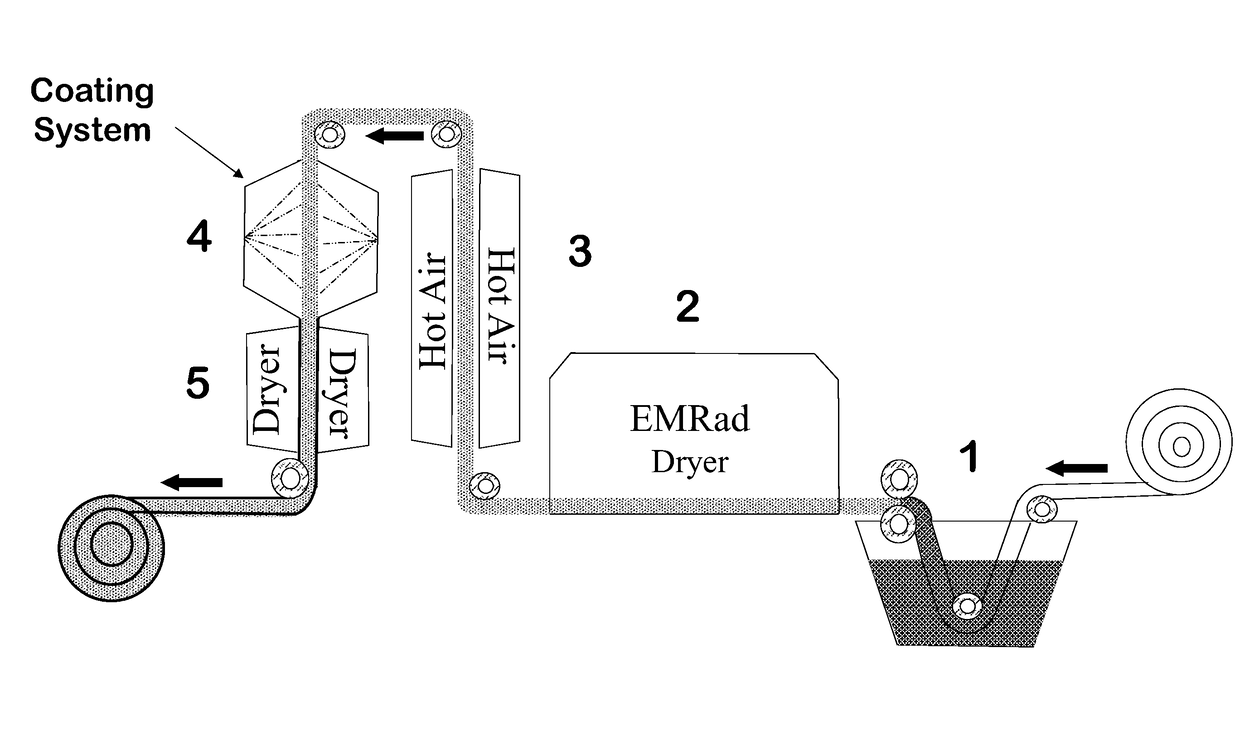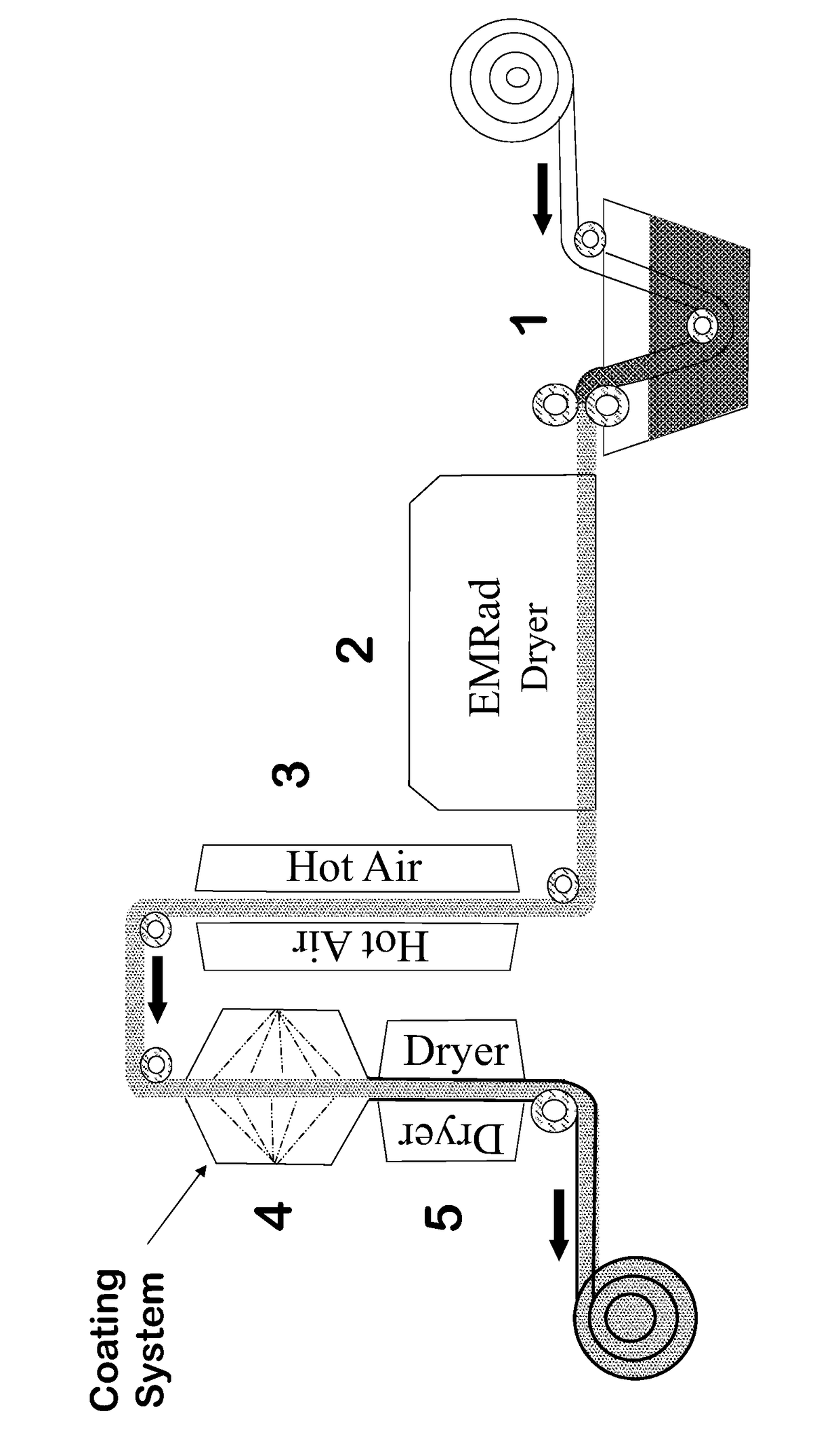Hydrophobic Fiberglass Thermal Insulation Materials
a technology of thermal insulation materials and hydrophobic blankets, which is applied in the direction of synthetic resin layered products, coatings, chemistry apparatuses and processes, etc., can solve the problems of excessive dust, over-expensive, and inability to perform the task well of previous thermal insulation materials, and achieves excellent hydrophobic properties, low thermal conductivity, and easy manufacture and application.
- Summary
- Abstract
- Description
- Claims
- Application Information
AI Technical Summary
Benefits of technology
Problems solved by technology
Method used
Image
Examples
example 1
[0047]A hydrophobic insulation blanket was made from fiberglass needle blanket and PTFE. A uniform dispersion for impregnation (first dispersion) was made in a 1-quart (1 L) container by adding 0.1 lb (45 g) of PTFE particles in a surfactant dispersion (Laurel AD-10, Laurel Products, LLC., Elverson, Pa.) with 0.5 lb (225 mL) of water, and agitating at 750 rpm for about 10 min.
[0048]Lewco fiberglass needle felts (Lewco Specialty Products Inc., Baton Rouge, La.) with a density of 10 lb / ft3 (0.15 kg / L) and a thickness of 0.5 inch (1.3 cm) were completely dipped / soaked in the PTFE dispersion. The soaked blankets were immediately nipped / pressurized (i.e., pressure-squeezed between rollers) to reach a total wet weight of 2.0 times the weight of the raw dry blankets, and the blankets were then transferred to a microwave oven for 15 to 60 min. The mass of water lost in the microwave oven was about 90 wt %. The blankets were then transferred to forced hot air (laboratory) drying equipment fo...
example 2
[0053]Historically, this Example 2 (which was unsuccessful) actually preceded Example 1 (which was successful). Example 2 can be used (in hindsight) to illustrate the effect that the manner of solvent evaporation has on the hydrophobicity of the produced blanket, as shown in Table 2. The procedures were largely the same as Example 1—with the principal exception that no EMRad oven was used. Water was instead evaporated from the wetted blanket with a traditional, convection oven. The blanket produced in this manner absorbed more than 5 wt % water, and thus did not satisfy the ASTM C 1511 test protocol. Conventional oven heating evidently resulted in a maldistribution of the PTFE dispersion in the produced blankets. Most of the PTFE apparently migrated to the (outer) surfaces of the blanket, leaving the center of the blanket largely devoid of hydrophobic components—meaning that the center readily absorbed water. By contrast, the blanket produced by EMRad drying (Example 1) had a much m...
example 3
[0054]Procedures were the same as in Example 1, except that blankets were made from fiberglass needle felts of differing densities and thicknesses. This Example examined the effect of the density and thickness of the raw blanket on the hydrophobicity of the produced blanket. Water absorption by the resulting blankets is summarized in Table 3, in which the reported values were measured in accordance with ASTM C 1511. All samples met the ASTM C 1511 standard of absorbing less than 5 wt % water, meaning that all were effective as hydrophobic fiberglass insulating blankets.
TABLE 3Effect of density and thickness of hydrophobic fiberglass needle felts.SampleDensityThicknessWater absorption17lb / ft30.3in3.7 wt %(110g / L)(8mm)27lb / ft30.5in2.9 wt %(110g / L)(13mm)310lb / ft30.5in2.8 wt %(160g / L)(13mm)410lb / ft30.6in3.3 wt %(160g / L)(15 mm)510lb / ft30.8in2.0 wt %(160g / L)(20mm)612lb / ft30.9in1.7 wt %(190g / L)(23mm)
[0055]These data showed that the final hydrophobicity of a processed blanket was largely in...
PUM
| Property | Measurement | Unit |
|---|---|---|
| particle size | aaaaa | aaaaa |
| specific surface area | aaaaa | aaaaa |
| thickness | aaaaa | aaaaa |
Abstract
Description
Claims
Application Information
 Login to View More
Login to View More - R&D
- Intellectual Property
- Life Sciences
- Materials
- Tech Scout
- Unparalleled Data Quality
- Higher Quality Content
- 60% Fewer Hallucinations
Browse by: Latest US Patents, China's latest patents, Technical Efficacy Thesaurus, Application Domain, Technology Topic, Popular Technical Reports.
© 2025 PatSnap. All rights reserved.Legal|Privacy policy|Modern Slavery Act Transparency Statement|Sitemap|About US| Contact US: help@patsnap.com


